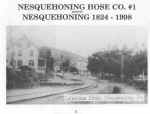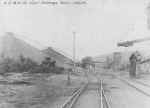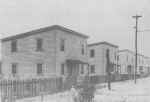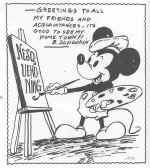
| |
|
This
is the 1998 Nesquehoning Calendar |
|
Cover |

|
Click on pictures to enlarge and click your back
button to return. |
|
January |

|
|
|
The girl's 1913 basketball team took a train to Palmerton
to play for the championship. Because it was too late to return home
after the game they stayed in Palmerton until the next day. When they
arrived at Nesquehoning's train station many fans were waiting to
congratulate them on their victory. From left - Jo Barry McCullian -
Bessie Campbell - Mildred McGorry - Violet Watt Thomas and Edna ?????.
Their coach was Harry Miller.
|
|
February |

|
|
|
On February 17, 1953, Kaijay Pants Company factory
located at 44 W. Catawissa St. was gutted by fire. The complete interior
and rear of the building, formerly the Newton Movie Theatre, was
ravished by flames. The fire started at 2:30 p.m. in the rear of the
building and took firemen from six Carbon County communities to
extinguish the stubborn blaze. It was estimated that machinery worth
$20,000 was destroyed and 10,000 garments consisting of slacks and
shorts were consumed by the fire. The factory employed seventy five
women. There was extensive damage to adjoining business places - The
Newton Drug Store which is immediately adjoining the factory and three
other business places, a novelty shop owned by Laura Watkins, a
restaurant conducted by Bill Stevenson and Shutack's Drug Store. Harry
Koplan, proprietor of Kaijay suffered from shock and necessitated
medical attention by Nesquehoning physician, Dr. Albert N. Redeline.
Charles Bonner, the Nesquehoning fire chief was threatened with injury
while fighting the blaze when his leg crashed through the roof. Fellow
firemen however, succeeded in freeing him.
|
|
March |

|
|
|
This1886 photo shows workers at Nesquehoning's new
breaker. This new breaker was needed to replace the one that burned to
the ground earlier that year. Hundreds of mules were used to provide
motive power at the collieries. Large stables were built to accommodate
the animals, some stables were underground. The mules were taken down
the shaft upon a cage and would spend the rest of their lives there. If
they were ill or suffered an injury they were brought to the surface and
allowed to roam in the corral until they recovered. Men, called mule
drivers were responsible for the safety of all animals in his
custody. If a driver lost a mule through carelessness or negligence or
abused a mule, he was fired immediately. A mule had an uncanny memory
and resented abuse in many ways. In a moment of anger, he would strike
at you with his forelegs or tramp on your feet. If a mule "lowered
his ears" the driver knew there was trouble brewing. Many mule
drivers pampered their animals by feeding them sweets such as candy,
lump sugar, apples and cookies. Some taught their mules to chew tobacco,
especially plug tobacco. Another driver had a different method of
displaying kindness to his mule. He come to work with two bottles of
beer, one for himself and the other for his "buddy." Mules
were taught four commands: gee meant to turn right; wah-haw, turn to the
left; whoa meant to stop and giddyap meant to go. The Lehigh Coal &
Navigation Co. kept accurate records concerning each mine mule the firm
owned, including "mule death certificates." The following are
from death certificates of Nesquehoning mules. Hero and Spring were
ordered put to death on June 16, 1913, with nor reason listed. Sept. 30,
1913, Dewey and Charlie were seriously injured and both had to be shot.
November 15, 1913, Tinker, Major and Taps were injured in #2 shaft and
had to be shot. March 20, 1914, Frank, 16 years old died from injuries
at #2 shaft. Sept. 1915, 10 year old Jennie died of heart failure. On
Feb. 15, 1916, Colonel, 12 years old was squeezed between two mine cars
and killed. Another mule named Dick died when his spine became
paralyzed. Miss Eva met her death when she got rammed by a pair of mine
cars. Gus died of natural causes and was sold to Reichard Hide and
Tallow Co. of Ashland for one dollar.
|
|
April |

|
|
|
The children from Nesquehoning were treated to this
Easter egg hunt in April 1938. It was held at the CCC camp at the East
End of town. The location of the CCC camp would later become a roadside
rest and is now the site of the Nesquehoning Hose Co. #1. After the
stock market crash in 1929 the Country fell into a great depression.
Many people were without jobs. President Franklin D. Roosevelt started
the CCC (Civilian Conservation Corps). People were offered an
opportunity to engage in healthful, outdoor work on forest, park and
soil conservation projects. They were paid $30 per month, the workers
were allowed to keep $5 and the remaining $25 was sent home to their
families. Company 3308CCC was made up of all black ex-soldiers, except
for one or two white officers. The original company strength was 187
enrollees and three officers. They built barracks, mess hall, recreation
building, tool shop, office, black smith shop, a garage to fix their
vehicles and Captain Lockridge’s quarters where he and his wife and
two children lived. Using picks, shovels and wheelbarrows these men
built fire roads through the mountain, a fire tower and cleaned out
streams at Farm Run and Shady Rest. They also did work in the four
hollows – like building rustic bridges across streams out of white
birch, cutting the under brush along the streams and roads, putting out
brush fires and cutting forage for deer to eat. Around 1940 the horrors
of WWII were raging in Europe and the camp got orders to disband and to
tear down all the buildings, piece by piece. All material was trucked to
Camp Hill to be used soon again by the Seabees, a branch of the armed
forces.
|
|
May |

|
|
|
The large wooden building, desolate and black,
looked like medieval castles with their many windows throwing back the
reflection of the sun. A coal breaker like an iceberg, is the portion of
a colliery that strikes the eye. The remaining 75% are shaft and slope
sinking, haulage roads, mines and planes. Unfortunately everything
coming out of a mine is not coal, it is a mixture of coal, rock, slate
and other foreign matter, and the breaker is for separating the black
wealth, This is a picture of the Nesquehoning breaker built in 1908. It
was steam powered until 1918 when it was electrified. In 1908 there were
796 employees inside the mines and 259 employees outside the mines. The
total production of coal that year was 381,422 tons, and was sold for
$2,288,532. In 1909 this breaker processed more than 502,000 tons and
712,000 tons in 1910. Weight was measured in long tons of 2,240. There
was 1,420 mine cars loaded at this breaker during a single day in August
1911. The coal mined in Nesquehoning and processed at this breaker had
the distinction of being the highest quality anthracite coal ever found.
It was abandoned Dec. 31, 1947 and on July 28, 1848 the breaker was sold
for scrap.
|
|
June |

|
|
|
This turn of the century photo shows workers ready to
shovel culm into coal cars at Nesquehoning, Many years ago when coal was
first discovered here, the Coal Company only mined large lump coal. This
was broken up by men with hammers. At that time the company only had
sale for large size coal, which they took in arks (boats) to
Philadelphia. The smaller size coal had no value, so it had to be
discarded somewhere out of the way. About 35% of the mine output was
disposed of as refuse. Millions of tons of this refuse or culm was
dumped between Nesquehoning and Hauto. In 1873 the company started to
find uses for smaller size coal and built the Hauto Screen Building.
Salvage of culm banks with yields from 15 to 60 percent in good pea and
stove coal was considered a good investment. Over 1.1 million tons of
culm were processed at Hauto in 1918. The Hauto washery was abandoned in
1924.
|
|
July |

|
|
|
In 1907 the Lehigh Coal & Navigation Company started
a coal storage yard west of Nesquehoning. During periods of low demand
they could store 360,000 tons of coal in the Hauto storage yard. This
area is now called Green Acres Industrial Park. Presently four
businesses occupy this property. They are - Heritage Frame & Glass
Creations, LTD. - Crystaline Buss & Rail Inc. - Viking Injector and
contractor William Farne.
|
|
August |

|
|
|
Around the turn of the century the Lehigh Coal &
Navigation Co. built these houses across the creek from Nesquehoning and
rented them to miners and their families. At first, the thirty double
dwellings were called Newtown. The name was changed to Snyderville, in
honor of the late Baird Snyder. In 1917 the name was changed again, this
time it would be called New Columbus. On October 15, 1917 at 5:30 New
Columbus had a great flag raising. Two tall poles, sixty feet high, were
erected side by side and a flag was swung to the top of each amidst the
firing of a salute and cheers of the crowd present. One was a large silk
American flag and the other Italy's National banner. Many of these
houses are in use today. Their are located on West Columbus
Avenue.
|
|
September |

|
|
|
During WWII the Country wanted everyone to conserve. Many
products were rationed - even food. People were urged to save old tires,
tin cans and plant gardens for Victory. This picture shows the vacant
lot across from the American Legion that was used as a drop off site for
metal that could be recycled. People in the picture are from left - Joe
Kenny - Ed Mulligan - Bob Bamford - John Panko - Claude Redline - Jimmy
Fauzio - Ed McGinley - Mark Davis and Police Chief Ed McGinley.
Nesquehoning was one of the most patriotic towns in the Country. On a
per capita basis, Nesquehoning had more people in the armed services
than any other town in the whole United States, (over 1200 men and
women.) One of the Countries first casualties in WWII was from
Nesquehoning. Joseph Malatak was killed on Dec 7, 1941 at Pearl Harbor.
Thirty-four people from Nesquehoning lost their lives in WWII.
|
|
October |

|
|
|
The Grotto-Shrine, adjacent of Our Lady of Mt. Carmel
Church, built in 1941, was dedicated to the memory of the hero dead of
the nation and as a thanksgiving memento for the safe return home of
members of the parish and their fellow service men to the nation after
World War II on October 15, 1945. It took many hours of the spare time
of a coal miner, Placido Guido LaRizzio, to alone build this unique
memorial. Rocks, earth and other mementos from over 100 places in the
world, make it a "miniature world" at which thousands of
visitors have felt close to people of all nations as they came to New
Columbus in the past years. Requests for prayers have come from
throughout the whole country. Many sick and distressed people were
blessed with water that flows from the rocks of the Grotto-Shrine.
|
|
November |

|
|
|
This is a picture of the "Breaker Boys" and
miners taken at Nesquehoning in 1890. A full measure of work was
expected from every boy as from every man. Josiah White, manager of the
Lehigh Coal & Navigation Co. Said, "a child must work to
prepare for life. Work taught reliability, self dependence and skills to
attain better jobs in manhood." Children as young as seven years
old, sat in their positions near the chutes, always facing the endless
stream of coal and removed slate, rock, slag, wood and other impurities
mixed with the coal. It was monotonous, backbreaking work. The boys
fingers developed "red tops" - when the outer skin was rubbed
off to expose the red flesh underneath. Their fingers were very painful
very minute of the day. The slate pickers boss always carried a stick
and would whack a youngster for getting into mischief or falling asleep.
Some of the slate pickers, victims of their own curiosity came to grief
and filled early graves. Leaning out of the windows of the high wooden
structures they topped to their death. Others lost limbs from
unprotected revolving wheels, ropes, belts and scraper lines. Breaker
Boys were paid 58 cents for a ten-hour day.
|
|
December |

|
|
|
If you were traveling up the Broad Mountain in the
1920's, half way up, your car's radiator would start belching steam like
Old Faithful. Like an oasis the Shady Rest comes into view. The sign
says - Park Here For Good Things To Eat. What a strategic place for a
restaurant and gas station. While the car's engine cooled, the driver
and passengers would treat themselves to a hot dog and soda or maybe a
large cone of Hazle Maid ice cream. Even cars coming down the mountain
would stop at Shady Rest to let their brakes cool. The steepness and the
seventeen curves made this highway the scene of many accidents.
|
|
Inside Back Cover |

|
|
|
This June 7, 1953 photo shows Kovatch's garage on the
left and the erection of a $400,000 stainless steel company plant on the
right. This building is now the world headquarters for the Kovatch
Corporation. In 1996 they celebrated their 50th anniversary. They
manufacture custom-built fire apparatus including pumpers, tankers,
rescue vehicles and a complete line of aerial trucks. They are also the
manufacturers of specialty vehicles, including fire apparatus and
aircraft refuelers, for the federal, military and international
marketplace. The photo also shows the new triangle entrance to the
community, completed only a couple months before this picture was taken.
Before the construction of this new road the main highway went up Allen
Street. Originally the road went from Nesquehoning to Summit Hill. In
1922 a new highway was built to connect Nesquehoning and Lansford and
the road to Summit Hill was abandoned. |
|
Inside Back Cover |

|
|
|
Nesquehoning Teachers - Front row from left: John
Williams, Kathryn Curry, Sue Mermon, Mary Moscoe, Emma Emanuel, Martha
Reichard, Brigie Dougherty , Julia Sutack, George Roscoe and Bob
Steventon. Second row: Sam Pagano, Mike Bonner, Percey Steventon, Gordon
Ulshafer, George Thear, Russ Miller, James Vaiana, William Thomas,
Warren Ulshafer, Rodney Grimm and Tony Mezza. |
|
Back Cover |

|
|
|
Cartoonist, Basil Davidovich lived in Nesquehoning
until he was 19 years old. After graduating from Pratt Institute,
Brooklyn, N.Y. in 1935 he was recruited by Walt Disney to help on what
would become Disney's greatest achievement- "Snow White."
Davidovich also worked on the other Disney features including
"Fantasia" - "Sword in the Stone", and "101
Dalmations". |
|